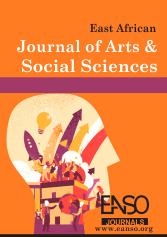Insidious Trauma in the Consciousnesses of the Zanzibari Arabs: A Reading of Selected Works of Abdulrazak Gurnah
Abstract
This paper examines insidious trauma by closely studying Abdulrazak Gurnah’s novels. It explores the complexity of migration within East Africa and to Britain by the Zanzibari Arabs represented in the novels, and glosses over their reasons for not going back to Oman in Arabia. The study purposively selected two of Gurnah’s novels that provide narratives with insights into insidious trauma. From the study findings, it is concluded that Gurnah’s fiction uses reverse chronology as a strategy that could lend insight into how the author reorganizes the Zanzibari Arabs’ history to confront the insidious trauma manifested in the form of social and political oppression. The study demonstrates how characters strive to define their identity and sense of belonging amidst their struggles with the painful past and highly discriminative present realities. It is demonstrated that, though not always blatant or violent, the effects of insidious trauma threaten the basic well-being of the person who suffers it.
Downloads
References
Abbas, H., Abbas, A., Iqbal, A., & Khalil, P. Z. (2023). Echoes of Haunted Memories and Nightmares: Understanding Trauma in Gurnah's Afterlives. University of Chitral Journal of Linguistics and Literature, 7(II), 99-105.
Bissell, W. C. (2011). Urban design, chaos, and colonial power in Zanzibar. Bloomington IN: Indiana University Press.
Brah, A. (1996). Cartographies of diaspora: Contesting identities. London: Routledge.
Brown, L. S. (1995). Not Outside the Range: One Feminist Perspective on Psychic Trauma. In C. Caruth (Ed.). Trauma: Explorations in Memory (pp. 100-112). Baltimore, MD: John Hopkins University Press.
Caruth, C., & Whitehead, A. (1996). The unclaimed experience: Trauma, narrative, and history. Baltimore: John Hopkins UP.
Claassens, L. J. M. (2020). Reading trauma narratives: insidious trauma in the story of Rachel, Leah, Bilhah and Zilpah (Genesis 29-30) and Margaret Atwood’s The Handmaid’s Tale. Old Testament Essays, 33(1), 10-31.
Gurnah, A. (2001). By the Sea. London: Bloomsbury.
Gurnah, A. (2011). The Last Gift. London: Bloomsbury.
Herman, J. (1992). Trauma and Recovery: The Aftermath of Violence--from Domestic Abuse to Political Terror. New York: Basic Books.
Lacan, J. (1998). The seminar of Jacques Lacan, Book IX: The four fundamental concepts of psychoanalysis (A. Sheridan, & W. W. Norton, Trans.). New York.
Laub, D. (1992). Bearing Witness or the Vicissitudes of Listening. In S. Felman and D. Laub (Eds.), Testimony: Crisis of Witnessing in Literature, Psychoanalysis, and History. New York: Routledge.
Root, M. P. P. (1992). Reconstructing the Impact of Trauma on Personality. In L. S. Brown & M. Ballou (Eds.), Personality and Psychopathology: Feminist Reappraisals (pp. 229-265). New York: The Guilford Press.
Thakur, M. K., & Sahi, N. K. (2024). The Struggle for Reconciliation: Trauma and Memory in Abdulrazak Gurnah’s By the Sea. International Journal of English Literature and Social Science, 9(6), 103-112.
Todorov, T. (1981). Introduction to Poetics. University of Minnesota Press.
Vickroy, L. (2014). Voices of Survivors in Contemporary Fiction. In M. Balaev (Ed.). Contemporary Approaches to Trauma Theory. (pp. 130-151). New York: Palgrave MacMillan.
Copyright (c) 2025 Seraphine Chepkosgei, PhD

This work is licensed under a Creative Commons Attribution 4.0 International License.




























